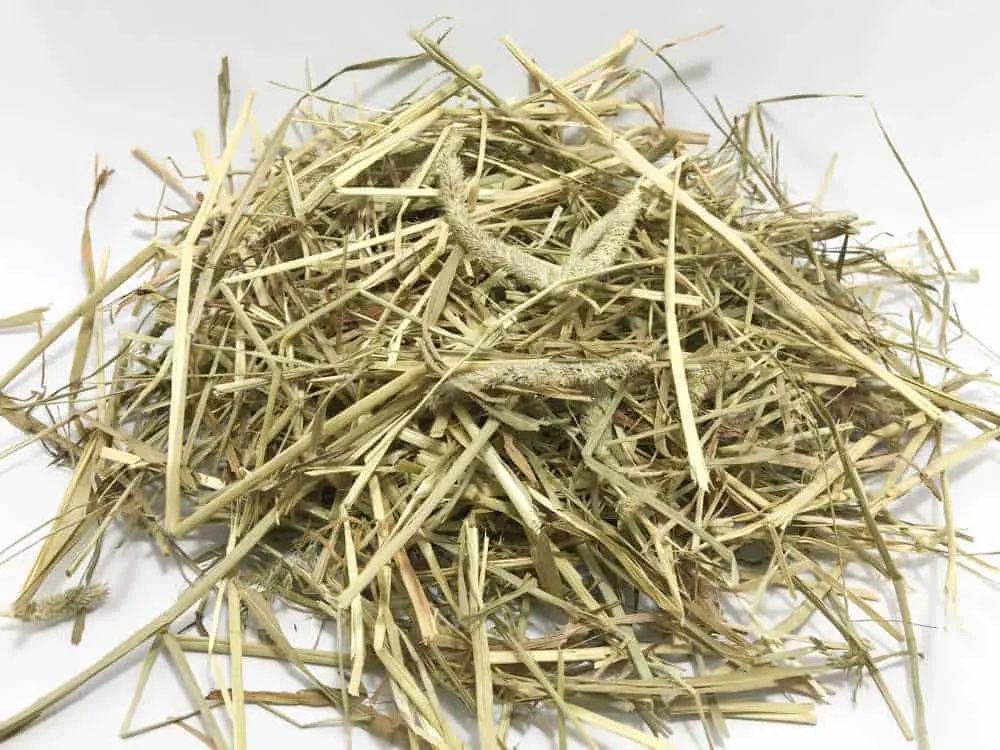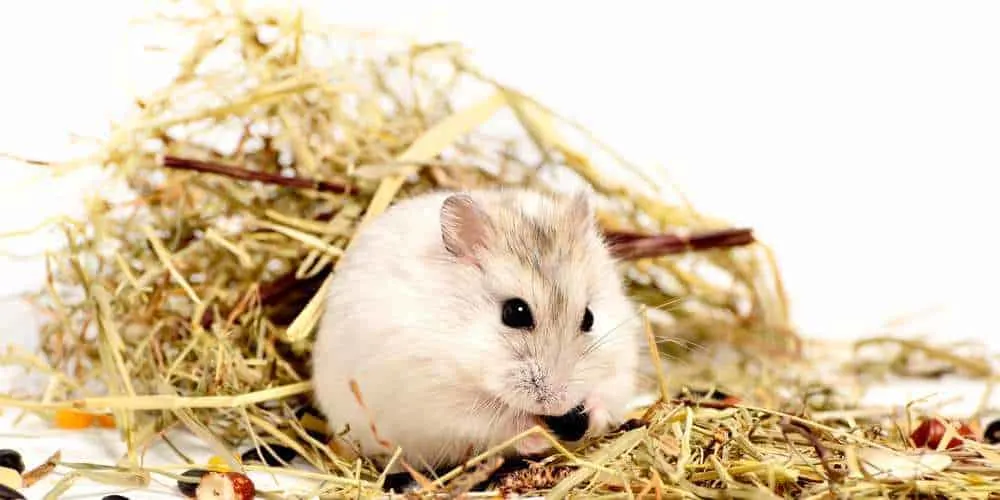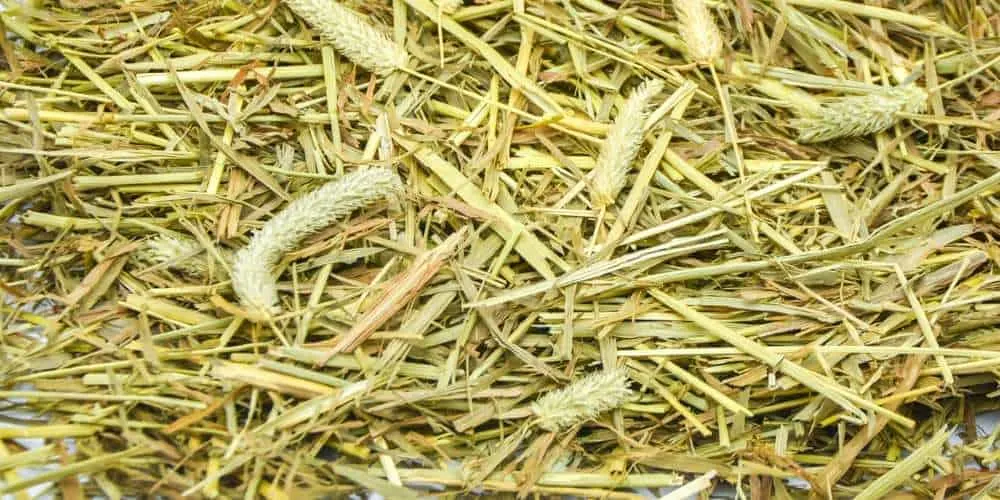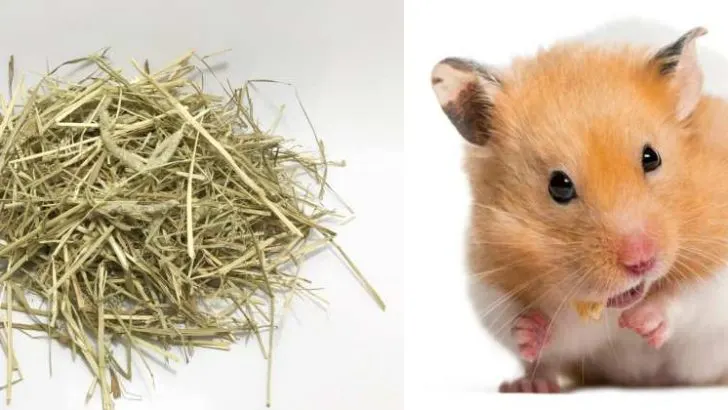You’ve all heard that in general hamsters eat regular hay. Based on this, it’s perfectly valid to ask yourself:
Can hamsters eat timothy hay? The answer is they most certainly can. Not only that timothy hay is not harmful to your pet, but from my experience and additional research, I can tell you it’s desired as a regular part of your hammy’s diet.
Even if the answer seemed obvious to you from the beginning, there are some things you should know about this food before feeding it to your pet, like with any other food.
In order to find out these useful pieces of information, and to learn a thing or two about your hamster’s diet and how to implement timothy hay into it, I suggest you make yourself cozy and keep reading.

Timothy Hay – Why Is It Actually Good?
As a hamster parent, the first thing I’ve learned about my furball’s diet is that fibers that are found in hay are a fundamental component of my pet’s diet.
This is because a long time ago, hamsters that were roaming the wild have based their diet on fiber-rich plants. This is simply because those kinds of plants were the most available to them.
This commodity that they have developed stuck with them until now. Even the hamsters that have never seen the outside world nor have explored it, need fiber in their food to keep a healthy tummy.
It’s needless to say that if they don’t get enough of it, you’ll have a mess to clean up afterward.
To prevent this, probably every vet that you talk to regarding your hamster’s diet will advise you to base their day-to-day diet on pellets.
This advice is given primarily because you don’t have to think about feeding your hamster every key component they need from different food sources, rather than giving them pellets that contain everything your hammy needs in just one serving.
Regardless of this, you should (and many vets will back me up on this) implement some hay in your hamster’s diet besides pellets. Some veggies and fruits are also O.K. but they are generally given as a snack (as they should be).
So, why is hay in close second place as the best food for your pet?
It’s plain and simple. Low in calories, rich in fiber, and extremely low price. All of these characteristics make it a phenomenal addition to your hamster’s diet.
Let’s break down all three of these, starting with low in calories:
- Protein makes up to 8% of this food, alongside a staggering 32% of protein (but more on that later). Protein is also essential to hamsters, giving them the energy to run around all day long, and be the little energy balls that we all know and love so much.
- When 14% of the moisture is taken into consideration you start to get a picture of how low in calories this food is.
- Another fantastic characteristic of timothy hay is that it’s rich in fiber. As I’ve already said, up to 32% of timothy hay is crude fiber. This is the biggest reason why all hamster owners try to make this grass an important part of their pet’s diet.
If this isn’t convincing enough for you, I assure you the price will make you join “team timothy”. Depending on the area of the world that you read this from the price of timothy hay might vary, but it’s one of the cheapest things you can feed to your hamster regardless of the part of the world you buy it in.
One more thing to keep in mind when thinking about timothy hay is that it’s probably the only food that’s not pellets that can be a regular part of your hamster’s day-to-day diet.
Any other veggies or fruits that you can imagine giving to your hammy can cause harm in one way or another if given too regularly or in too big a volume. I think this says a lot about timothy hay alone.

Can Timothy Hay Be Harmful To Hamsters?
I’ve never witnessed or heard that timothy hay caused any serious problems to hamsters.
There’s logically nothing in this food that can be considered a threat to your hammy. The simple contents and the organic way of growing it makes timothy hay a perfectly healthy option.
There’s only one thing you should pay attention to when feeding this food to your hamster, and it’s the amount of it. Fiber and protein are good, but in an extensive amount, they can cause some problems.
These problems may vary, but in most cases, they will be some minor digestive problems like an irregular stool or maybe some constipation or diarrhea.
Constipation can occur if your pet eats less fiber than needed, due to the dehydrated pellets that are the main component of their diet. This also depends on the amount of water they drink in a day.
Diarrhea is the complete opposite of this, and it occurs when your hammy eats more fibers than needed. This can also happen if you give it more vitamin C than needed. To prevent this, just keep in mind your hamster’s size when deciding on the amount of food you give them.
On the rare occasion, your pet experiences this, depending on the severity of the problem you should contact your vet and ask for advice on what digestive supplements you should give to your hamster, or is there any need for any veterinary intervention.
Chances of this happening are slim to none, but It’s my duty to prepare you even for that. A responsible pet owner should be aware of all scenarios and should educate himself on how to react in all of them!

How Do Hamsters Use Timothy Hay?
Well, it’s obvious from the text that the main use of timothy hay in a hamster’s life is dietary. But, there are some instances where your hammy won’t eat its timothy hay, but rather use it as bedding.
Hamsters are animals that enjoy comfort, so they’ll use it as described if they see fit. This is a good indication that maybe it’s time for new bedding or even a new layout of your hamster’s living space.
If it sets the new bedding somewhere different from its previous bedding, this indicates that it’s time for a change, but if it just replaces the old bedding with new timothy hay, that’s just an indicator they need a fresh place to sleep.
Don’t worry – once they do what they want with it, next time you feed timothy hay to them they’ll probably eat it.
If your hammy makes itself new bedding, just make sure to take the old bedding out of the cage to prevent rotting.
On the other hand, you can use timothy hay in a stimulating feeding time game. What I like to do is take an empty toilet paper roll and cut two or three triangles on each side of the roll. Next, I fill the roll with timothy hay in a way that it’ll be hard for them to get it out through the big opening.
Instead of that, what they’ll do is they’ll pull the hay through the small triangles that I’ve cut out earlier. This regulates the speed of your hamster’s eating preventing overeating, plus it’ll make the feeding time much more fun!
Another thing you can do is you can hand timothy hay from the ceiling of your hamster’s cage (where they can reach it) and let them go and find it.
This stimulates them to “hunt” for their food, which makes feeding time much more satisfactory for your hamster.
Essentially anything that makes your hamster work for their food will make them happy and excited when they realize it’s feeding time!

Conclusion
To me, the answer to the question – can hamsters eat timothy hay is quite obvious. They absolutely can and should. This is one of those foods that are not only allowed but desired as a good and healthy component of your hammy’s diet.
The fact that this food doesn’t cause any serious side effects should make you relaxed as much as possible, and not wondering if you should or shouldn’t have fed your pet timothy hay.
My advice to my fellow hamster owners is to go out, find some fresh, green, and sweet-smelling timothy hay and watch your hamster go wild when you give it to them!

